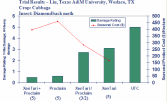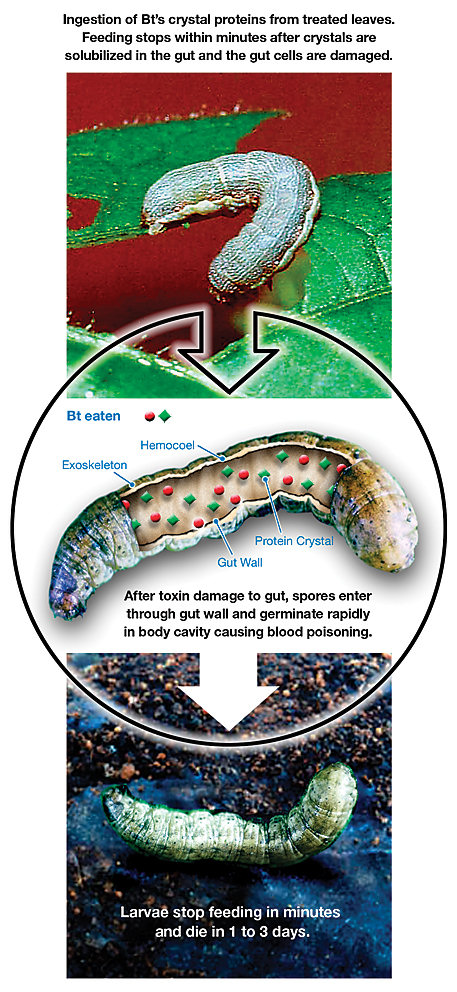What Is Bt?
 Bacillus thuringiensis (Bt) is one of the most common microorganisms used in insecticides to control target insects using an environmentally benign, biologically-based agent. Bts are naturally-occuring throughout most regions of the world, are common in soil and on plant leaves and are biodegradable.
Bacillus thuringiensis (Bt) is one of the most common microorganisms used in insecticides to control target insects using an environmentally benign, biologically-based agent. Bts are naturally-occuring throughout most regions of the world, are common in soil and on plant leaves and are biodegradable.
Bt is a biological insecticide that:
- Is harmless to humans, birds, and other beneficial wildlife.
- Creates toxins lethal to many pest and disease-carrying insect species, such as caterpillar, beetle, and mosquito larvae.
- Is a rod-shaped microorganism (bacterium) that produces protein toxins during sporulation (spore production process).
- Provides insecticidal properties through commercial Bt products. These commercial Bt products contain protein toxin crystals or a mixture of crystals and Bt spores.
How Do Bts Work?
 Bts contain protein endotoxin crystals and living spores. With insect populations, the protein endotoxin acts as a selective stomach poison. Spores contribute to their toxicity by causing blood poisoning and providing persistence in the insect’s system.
Bts contain protein endotoxin crystals and living spores. With insect populations, the protein endotoxin acts as a selective stomach poison. Spores contribute to their toxicity by causing blood poisoning and providing persistence in the insect’s system.
When an insect pest ingests the crystal proteins from leaves treated with Bt, feeding stops within minutes after the crystals are made soluble in the gut and gut cells are damaged. After toxin damage to the gut occurs, spores enter through the gut wall and germinate rapidly in the body cavity causing blood poisoning. Larvae stop feeding on the crop within minutes and die in 1-3 days. The affected larvae move slowly, discolor, then shrivel, blacken, and die. Smaller larvae die more quickly, suggestsindicating that precise timing can measurably improve the performance of the Bt application.
Some pest species are difficult to control with toxin alone. Germinating Bt spores provide an additional control mechanism:
- Spores germinate in the midgut and spread throughout, ultimately causing septicaemia (blood poisoning) and death.
- Additional mortality (synergistic effect) is especially apparent in armyworm larvae, which can be difficult to control with toxin alone.
- Products with viable spores (such as DiPel and XenTari) have a distinct advantage over products without spores.
What Types Of Bt Exist?
Thousands of Bt strains exist within the various Bt subspecies. Each individual strain produces its own
insecticidal protein toxin mix targeting specific groups of pests. There are more than 80 different subspecies of
Bt, but commercially, only the following are currently used:
- Bt kurstaki (Btk) : Used for caterpillaer control
- Bt aizawai (Bta) : Used for caterpillar control with specific activity on armyworms
- Bt tenebrionis (Btt) : Used to control beetle larva
- Bt israelensis (Bti) : Used to control mosquito, black fly and fungus gnat
Bt Pest Control From Valent BioSciences
High-quality agricultural Bt products from Valent BioSciences Corporation (VBC) are available and sold in more than 100 countries around the world under a variety of names.:
DiPel: Bt kurstaki (Btk) is sold under the brand name DiPel in addition to being sold as Biobit and Bactospeine. DiPel is a broad-spectrum worm/caterpillar product for use on vegetables, fruits, nuts, vines, corn, cotton, soybeans, turf, and other crops. It controls more than 55 caterpillar pests including: leaf-rollers, bollworms, loopers, hornworms, cutworms, and corn borers. A key benefit of DiPel is its status as a nonrestricted use pesticide. It does not require a restricted use permit for either purchase or use, and can be applied up to the time of harvest, although regional regulations vary and should be consulted for allowable preharvest intervals (PHI).
XenTari: Bt aizawai (Bta) is sold as XenTari and Florbac. This unique broad-spectrum worm/caterpillar product is particularly effective in controlling armyworms and Diamondback Moth larvae. It is registered for use on vegetables, fruits, nuts, row crops, and turf and is the most effective tool for resistance management.
Understanding Bt Potency
Quality control in harvesting and packaging Bts is critical to their potency. Measuring Bt potency helps a company provide consistency of the product from one batch to the next. One of the common methods used for quality control methods is the International Units (IU) method established in 1971. Different companies use different methods and insects to measure potency, all arriving at product labels that provide growers with specific directions for best effective use.
Product labels contain important guidance. It is important to understand that different species have different susceptibilities to Bt toxins and Bt products have different profiles of these toxins.
A One – Two Punch: Bts Help Maintain Beneficial Insects and Habitats
Integrated pest management (IPM) programs are especially important to organic fruit and vegetable growers. A critical component of IPM is building and maintaining beneficial insect populations. This process starts with creating a beneficial habitat, and it is where the use of Bt can fill an important role. Read more.
Bt Value: The Big Picture
With nearly 40 years of proven performance in the field, Bt’s ability as effective pest control is well known. Pest management professionals will also tell you biorationals work best with careful management. Read more.
Bt Results by the Numbers
Bt field trials produce interesting results for its use in tank mix or rotation with other chemistries. The numbers don’t lie, and the results are dramatic. Marcus Adair is the Senior Field R&D Scientist at Valent BioSciences in Oxford, MS. When he coordinated a series of Bt field trials with cooperators in Florida, California, Texas, and the Carolinas, the objective was to gather hard data on the economic impact of using Bt in tank mix and rotation alongside a variety of other effective chemistries. Read more.
Bt Strains Make A Big Difference
Within the species Bacillus thuringiensis (Bt), there are several types, or subspecies, with specific activity against various insect pests. Going one step further, thousands of strains – genetic lines, or subtypes, exist within the various Bt subspecies. Read more.
